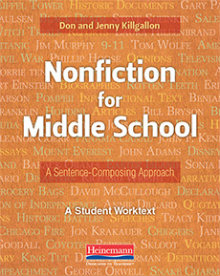A Sentence-Composing Approach to Nonfiction
Nonfiction for Middle School: A Sentence-Composing Approach
By Donald and Jenny Kilgallon
(Heinemann, 2016 – Learn more)

If we helped students admire the beauty and craft of nonfiction, the Titanic and the invasion of Normandy would be as hot as Harry and Percy. Nonfiction for Middle School: A Sentence-Composing Approach puts the words of talented nonfiction authors and essayists at the center of its workbook style.
However, for this workbook to work in most middle school classrooms, other structures need to be in place already.
Limited classroom audience

Modeling responses in this particular way assumes that students not only have practice with part-of-speech identification but also that they are ready to do independent transformations of passages that are at or above grade level for most middle school readers.
Another limiter is this workbook’s use of vocabulary around grammar. Comma patterns are identified only as opening commas, closing commas, and subject-verb split commas. While noticing and naming commas in this way gives a benefit of simplicity, I would rather students understand comma patterns by purpose rather than location.
For example, an absolute phrase will always provide more information about the subject, but it can be before an opening comma or after a closing comma. And what about commas that don’t fit that format, like list commas, coordinating phrase commas, and nonrestrictive clause commas?
To avoid confusion I would only use these workbook activities if you are committed to teaching and reinforcing the vocabulary chosen by the authors of the workbook.
Blunting beauty through grammar instruction
Everyone can cook with salt. But Bobby Flay and Gordon Ramsay know when best to use it and how much to use.
We need to remind readers and writers of the same when we teach sentence structure: just because we can identify an ingredient of good writing doesn’t mean we should always use it or that it always makes writing better. The novice writer need not pepper every sentence with commas just because teacher said it often helps.
For example, this text shows two sentences in a before-and-after format. The implication is that the “after” is always better than the “before” because “after” has more information.
Here is a sample before-and-after to show “opener” commas:
Before: The smell of burned flesh hit Pete even before the hatch was completely open.
After: As the helicopter came down between the pine trees and settled onto the bogs where the accident has occurred, the smell of burned flesh hit Pete even before the hatch was completely open. (From Tom Wolfe, The Right Stuff. Page 39, bold and italics from text)
When I compare these two sentences, I don’t see a clear before and after as much as I see different. The “before” sentence places emphasis on the smell; the “after” sentence puts the smell in the context of immediate past events and establishes a setting. The way I see it, both sentences halves are phenomenal, and I’d rather have students attuned to the beauty of Wolfe’s writing rather than his use of a comma.
A field guide, not an instruction manual
I plan to use zero of the activities in this book as prescribed, but I will squeeze the juice out of each and every one of the nonfiction mentor sentences that the Kilgallons present. Their choices cross genres, topics, and cultures, with beauties like:
The youngest and only boy of four children, Nelson and his father cared for cattle and sheep. (From Barry Denenberg, Nelson Mandela: No Easy Walk to Freedom, quoted on p. 211)
Let’s stop for a moment and admire that sentence. Hmmm. I wonder why the author gave us that additional information about Nelson’s family life at the beginning of the sentence. Do we feel a little bit of sympathy for Nelson, given that he has three older sisters who are getting more attention? Or are they getting more attention? Why weren’t his sisters helping out with the cattle and sheep? Did Nelson and his father become particularly close because they worked together? Where could we as writers add additional information to make our readers ask more questions?
The great Channel refused to be taken easily by anyone, whether in great ships or a simple swimsuit. The thought of a woman doing it seemed preposterous to many, especially a teenager who couldn’t understand the difficulties she would face. (From Tim Dahlberg, Mary Ederle Ward, and Brenda Green, America’s Girl: The Incredible Story of How Swimmer Gertrude Ederle Changed the Nation, quoted on p. 122)
How interesting that this passage starts out with a challenge to “anyone,” human or machine alike. That information makes me even more likely to root for this younger teenage female who wants to take on the Channel – and it makes me question her common sense, too.
We need more tools for teaching excellent nonfiction
This book reveals that pristine nonfiction writing already exists, and that we as teachers need more tools to share it with our students if we want them to love nonfiction the same way we already do.
Amy Estersohn teaches middle school English in New York. She is a recipient of the NCTE/ALAN Gallo Grant. She writes graphic novel reviews for No Flying No Tights and about workshop teaching at Three Teachers Talk. Follow her on twitter at @HMX_MsE.

































To hold a reader’s attention, the author needs sentence variety, so rules like “the after is always better than the before,” doesn’t really make sense. Thank you for the review.